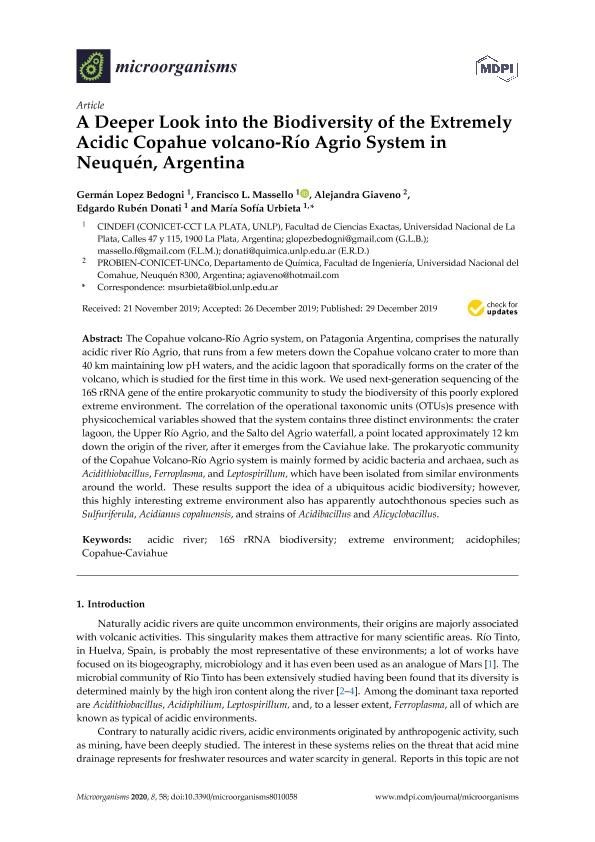Artículo
A deeper look into the biodiversity of the extremely acidic copahue volcano-río agrio system in Neuquén, Argentina
López Bedogni, Germán Agustín ; Massello, Francisco Luis
; Massello, Francisco Luis ; Giaveno Filippa, Maria Alejandra; Donati, Edgardo Ruben
; Giaveno Filippa, Maria Alejandra; Donati, Edgardo Ruben ; Urbieta, María Sofía
; Urbieta, María Sofía
 ; Massello, Francisco Luis
; Massello, Francisco Luis ; Giaveno Filippa, Maria Alejandra; Donati, Edgardo Ruben
; Giaveno Filippa, Maria Alejandra; Donati, Edgardo Ruben ; Urbieta, María Sofía
; Urbieta, María Sofía
Fecha de publicación:
01/2020
Editorial:
MDPI AG
Revista:
Microorganisms
ISSN:
2076-2607
Idioma:
Inglés
Tipo de recurso:
Artículo publicado
Clasificación temática:
Resumen
The Copahue volcano-Río Agrio system, on Patagonia Argentina, comprises the naturally acidic river Río Agrio, that runs from a few meters down the Copahue volcano crater to more than 40 km maintaining low pH waters, and the acidic lagoon that sporadically forms on the crater of the volcano, which is studied for the first time in this work. We used next-generation sequencing of the 16S rRNA gene of the entire prokaryotic community to study the biodiversity of this poorly explored extreme environment. The correlation of the operational taxonomic units (OTUs)s presence with physicochemical variables showed that the system contains three distinct environments: the crater lagoon, the Upper Río Agrio, and the Salto del Agrio waterfall, a point located approximately 12 km down the origin of the river, after it emerges from the Caviahue lake. The prokaryotic community of the Copahue Volcano-Río Agrio system is mainly formed by acidic bacteria and archaea, such as Acidithiobacillus, Ferroplasma, and Leptospirillum, which have been isolated from similar environments around the world. These results support the idea of a ubiquitous acidic biodiversity; however, this highly interesting extreme environment also has apparently autochthonous species such as Sulfuriferula, Acidianus copahuensis, and strains of Acidibacillus and Alicyclobacillus.
Archivos asociados
Licencia
Identificadores
Colecciones
Articulos(CINDEFI)
Articulos de CENT.DE INV EN FERMENTACIONES INDUSTRIALES (I)
Articulos de CENT.DE INV EN FERMENTACIONES INDUSTRIALES (I)
Citación
López Bedogni, Germán Agustín; Massello, Francisco Luis; Giaveno Filippa, Maria Alejandra; Donati, Edgardo Ruben; Urbieta, María Sofía; A deeper look into the biodiversity of the extremely acidic copahue volcano-río agrio system in Neuquén, Argentina; MDPI AG; Microorganisms; 8; 1; 1-2020; 1-14
Compartir
Altmétricas



